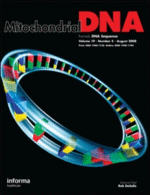Mexico barcode surprises
In December 2010 Mitochondrial DNA special issue (open access!) devoted to the Mexican Barcode of Life Initiative (MexBOL), Mexican scientists and colleagues report on barcoding explorations of their megadiverse fauna and flora. A few highlights:
 Martínez-Salazar and León-Règagnon from University of Guelph and Universidad Nacional Autónoma de México respectively, examined two morphospecies of Langeronia lung flukes that parasitize Mexican frogs, finding three deeply divergent clusters (approximately 8% uncorrected sequence divergence among specimens from the different regions and 0.3% within). Surprisingly, these clusters were observed in both morphospecies (and did not differ among host species). Based on their results, the researchers conclude that the morphospecies are conspecific, perhaps representing alternative developmental pathways, but it may also be that there are species-level biological differences among the clades not yet recognized. Of note, the 368 bp COI fragment analyzed only partly overlaps the standard barcode region; primers effective for Trematodes are needed.
Martínez-Salazar and León-Règagnon from University of Guelph and Universidad Nacional Autónoma de México respectively, examined two morphospecies of Langeronia lung flukes that parasitize Mexican frogs, finding three deeply divergent clusters (approximately 8% uncorrected sequence divergence among specimens from the different regions and 0.3% within). Surprisingly, these clusters were observed in both morphospecies (and did not differ among host species). Based on their results, the researchers conclude that the morphospecies are conspecific, perhaps representing alternative developmental pathways, but it may also be that there are species-level biological differences among the clades not yet recognized. Of note, the 368 bp COI fragment analyzed only partly overlaps the standard barcode region; primers effective for Trematodes are needed.
Cervantes and colleagues (same institutions as above) demonstrated that Common Opposum (Didelphis marsupialis) and Virginia Opposum (D. virginiana), which are sympatric (live in the same area) in Mexico, are readily distinguished by COI barcode (average K2P distances between species are approximately 8%, and within are 1.5%). These species have diagnostic skull morphology but external characters are unreliable, making field identification inaccurate and even museum specimens can be misidentified, including 4 museum specimens in this study.
Zaldívar-Riverón and colleagues from Mexico, Canada, and Argentina applied DNA barcoding to braconid wasps collected during three field trips during 2009 in the Chamela-Cuixmala biosphere reserve, near the Pacific coast. Braconidae is an extraordinarily rich (50,000 -150,000 species) family of tiny parasitoid wasps that attack butterfly larvae, with many species exquisitely specialized to a single host. The researchers obtained barcode sequences from 407 of 483 specimens, and applied computer software (Yule coalescent model) to estimate how many species were present, which turned out to be 185! I’m guessing they sorted specimens to select different morphospecies before sequencing, as it seems improbable that there could be 185 different species among 407 randomly-collected specimens. In this short report, the researchers did not comment on how many of the “barcode coalescent species” correspond to known wasp species. The rate of species discovery did not plateau over the course of the study, pointing to many, many more braconid wasps in just this one area.
At the beginning of the barcode initiative, there was worry from some taxonomists that it wouldn’t work. After 8 years, we know now that a comprehensive library built around taxonomic reference specimens unambiguously names 95% of animal species from mayflies to mammals, and resolves the remainder into small sets of closely-related species. Looking ahead, it seems obvious that one or another analytic approach, such as coalescent modeling described above, will enable construction of a provisional species and higher-level taxonomy from barcode data alone which will be particularly useful for impossibly diverse or poorly-studied groups, such as nematodes. Experts will improve this draft taxonomy as other information becomes available.
I have long thought that the biggest scientific challenge raised by DNA barcoding is not that it doesn’t work to distinguish some closely-related species, but that it works too well–it reveals biodiversity is much more finely divided and highly-specialized than we knew. Even in birds, the best studied large taxonomic group, a comprehensive DNA barcoding survey demonstrated that 24% of bird species that live in Europe and North America are comprised of isolated populations that have been diverging for more than a million years, likely representing distinct species (Johnson J Ornithol 2010; open access). To my mind, the big picture results so far are an exciting provocation–we need to better understand specialization–how do organisms navigate their environment—for example what signals (chemical, behavioral, acoustic, electric, visual?) enable a wasp to find and distinguish one butterfly larvae from another, or to determine whether the larva is already parasitized? Animals can be viewed as highly-discriminating and sensitive detectors of other life forms. A genetic approach might identify parts of the nervous system or sensory system that enable these feats. With better understanding we might construct highly-specific biosensors, say to detect pathogens.
Addendum: Correcting my supposition about whether specimens were sorted prior to barcoding, Dan Janzen tells me that high species counts are the norm when collecting braconid wasps in tropical sites, such that 185 braconid wasp species from 483 specimens is not unusual.
This entry was posted on Friday, February 11th, 2011 at 9:09 pm and is filed under General. You can follow any responses to this entry through the RSS 2.0 feed. Both comments and pings are currently closed.
February 14th, 2011 at 1:46 pm
[…] This post was mentioned on Twitter by Systematic Biology, Andrew Spong. Andrew Spong said: The Barcode of Life blog » Blog Archive » Mexico barcode surprises: In December 2010 Mitochondrial DNA special i… http://bit.ly/gNcHdA […]